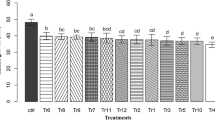Abstract
Morphological studies of Chalaropsis punctulata and Thielaviopsis paradoxa revealed that the two fungi are similar to each other and produce endoconidia from phialidic conidiophores and thick dark-walled and pigmented aleuroconidia from conidiophores. There are minor morphological characters which separate the fungus Ch. punctulata from T. paradoxa: the latter form aleuroconidia in chains at the tip of specialized hyphae, whereas the former produce aleuroconidia singly. The percent inhibition of mycelial growth and the total count of conidia showed good inhibitory effects in all biocontrol methods used. The antagonist activity of Trichoderma harzianum against Ch. punctulata was due mainly to coil formation and hyphae grew alongside of the pathogen hyphae. Both hyphae and conidia of Ch. punctulata were malformed and swelled abnormally in the case of Bacillus isolates. This is the first report of Ch. punctulata on date palm in Egypt.




Similar content being viewed by others
References
Abbas, E. H., & Abdulla, A. S. (2003). First report of neck bending disease on date palm in Qatar. Plant Pathology, 52, 790.
Abbas, E. H., Al Izi, M. J., Aboud, H. M., & Saleh, H. M. (1997). Neck bending, a new disease affecting date palm in Iraq. Proceedings of the 6th Arab Congress on Plant Protection. Beirut, Lebanon.
Abdullah, S. K., Asensio, L., Monfort, E., Gomez-Vidal, S., Salinas, J., Lopez Lorca, L. V., et al. (2009). Incidence of the two date palm pathogens, Thielaviopsis paradoxa and T. punctulata in soil from date palm plantations in Elx, South-East Spain. Journal of Plant Protection Research, 49, 276–279.
Al-Ani, A. S. (1958). The genetic of Ceratostomella radicicola and the phylogenetic relationship between Chalaropsis and Chalara. American Journal of Botany, 45, 228–232.
Alvindia, D. G., & Natsuaki, K. T. (2009). Biological activities of Bacillus amyloliquefaciens DGA14 isolated from banana fruit surface against crown rot-causing pathogens. Crop Protection, 28, 236–242.
Djerbi, M. (1983). Diseases of date palm (Phoenix dactylifera). FAO regional project for Palm and Dates Research Centre in the Near East and North Africa. Baghdad, Iraq: FAO.
Eziashi, E. I., Uma, N. U., Adekunle, A. A., & Airede, C. E. (2006). Effect of metabolites produced by Trichoderma species against Ceratocystis paradoxa in culture medium. African Journal of Biotechnology, 5, 703–706.
Eziashi, E. I., Omamor, I. B., & Odigie, E. E. (2007). Antagonism of Trichoderma viride and effects of extracted water soluble compounds from Trichoderma species and benlate solution on Ceratocystis paradoxa. African Journal of Biotechnology, 6, 388–392.
Haram, S., Schickler, H., Oppenheim, A., & Chet, I. (1996). Differential expression of Trichoderma harzianum chitinases during mycoparasitism. Phytopathology, 86, 980–985.
Howell, C. R. (2003). Mechanisms employed by Trichoderma species in the biological control of plant diseases: the history and evolution of current concepts. Plant Disease, 87, 4–10.
Imtiaj, A., & Lee, T. (2008). Antagonistic effect of three Trichoderma species on the Alternaria porri pathogen of onion blotch. World Journal of Agricultural Sciences, 4, 13–17.
Korsten, L., De Jager, E. S., Villiers, E. E., Lourens, A. J., Kotze, M., & Wehner, F. C. (1995). Evaluation of bacterial epiphytes from avocado leaf and fruit surfaces for biocontrol of avocado postharvest diseases. Plant Disease, 79, 1149–1156.
Linde, C., & Smit, W. A. (1999). First report of rhizosis caused by Ceratocystis radicicola on date palms in South Africa. Plant Disease, 83, 880.
Molan, Y. Y., Al-Obeed, R. S., Harhash, M. M., & El-Husseini, S. (2004). Decline of date palm offshoots infected with Chalara paradoxa in Riyadh region. Journal of the King Saud University—Agricultural Science, 16, 79–86.
Paulin, A. E., & Harrington, T. C. (2000). Phylogenetic placement of anamorphic species of Chalara among Ceratocystis species and other ascomycetes. Studies in Mycology, 45, 209–222.
Paulin-Mahady, A. E., Harrington, T. C., & McNew, D. (2002). Phylogenetic and taxonomic evaluation of Chalara, Chalaropsis, and Thielaviopsis anamorphs associated with Ceratocystis. Mycologia, 94, 62–72.
Polizzi, G., Castello, I., Aiello, D., & Vitale, A. (2007). First report of stem bleeding and trunk rot of Kentia palm caused by Thielaviopsis paradoxa in Italy. Plant Disease, 91, 1057.
Sanchez, V., Rebolledo, O., Picaso, R. M., Cárdenas, E., Córdova, J., González, O., et al. (2007). In vitro antagonism of Thielaviopsis paradoxa by Trichoderma longibrachiatum. Mycopathologia, 163, 49–58.
Sivakumar, D., Wijeratum, R. S. W., Abeyskara, M., Wijesundera, R. L. C., Marikarikar, F. M. T., & Abeyskara, M. (2000). Antagonistic effect of Trichoderma harzianum on postharvest pathogens of rambutan. Phytoparasitica, 28, 240–247.
Suleman, P., Al Musallam, A., & Menezes, C. A. (2001). The effect of solute potential and water stress on black scorch caused by Chalara paradoxa and Chalara radicicola on date palms. Plant Disease, 85, 80–83.
Wijesinghe, C. J., Wijeratnum, R. S. W., Samarasekara, J. K. R. R., & Wijesundera, R. L. C. (2010). Biological control of Thielaviopsis paradoxa on pineapple by an isolate of Trichoderma asperellum. Biological Control, 53, 285–290.
Yoshida, S., Hiradate, S., Tsukamoto, T., Hatakeda, K., & Shirata, A. (2001). Antimicrobial activity of culture filtrate of Bacillus amyloliquefaciens RC.2 isolated from mulberry leaves. Phytopathology, 91, 181–187.
Zaid, A., de Wet, P. F., Djerbi, M., & Oihabi, A. C. (2002). Diseases and pests of date palm. In A. Zaid & E. Arias-Jimenez (Eds.), Date palm cultivation, (pp. 227–281). FAO Plant Production and Protection Paper 156.
Author information
Authors and Affiliations
Corresponding author
Rights and permissions
About this article
Cite this article
Ammar, M.I. First report of Chalaropsis punctulata on date palm in Egypt, comparison with other Ceratocystis anamorphs and evaluation of its biological control. Phytoparasitica 39, 447–453 (2011). https://doi.org/10.1007/s12600-011-0179-z
Received:
Accepted:
Published:
Issue Date:
DOI: https://doi.org/10.1007/s12600-011-0179-z




